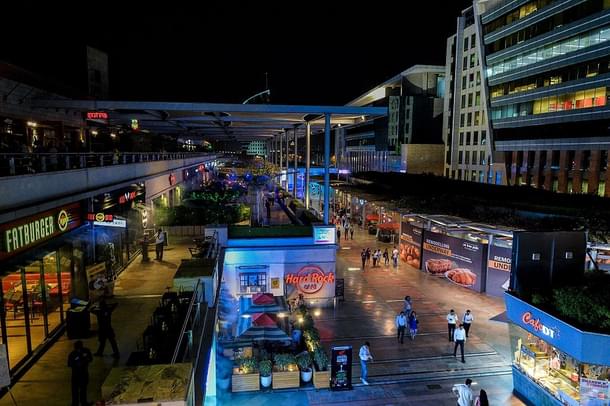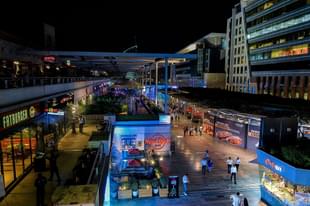Economy
Megaregions Stretching Across Multiple States Will Drive Future Growth: Ashok Malik
Swarajya Staff
Oct 19, 2016, 03:04 PM | Updated 03:04 PM IST
Save & read from anywhere!
Bookmark stories for easy access on any device or the Swarajya app.


Ashok Malik is a senior journalist and a commentator on contemporary affairs. He is a columnist with several leading publications in the country and a distinguished fellow at one of India’s premier think-tanks, Observer Research Foundation. This year, the Government of India awarded Malik the Padma Shri in ‘Literature and Education’ category.
Malik’s latest piece, where he argues that States are yesterday’s story and megaregions running across state boundaries will be the drivers of future growth, has stirred a lot of discussion and debate.
Swarajya had some questions for Malik and he was happy to elaborate on his idea. Here is the full transcript of the interview.
Industrial corridors/Special Economic Zones (SEZs) haven't taken off in India so far despite constant efforts of the successive governments. How would the success or failure of say, Bengaluru-Chennai or Delhi-Mumbai corridors impact these megaregions?
I have not suggested these are SEZs. SEZs are very different. I am saying these are three mega-clusters of economic and industrial activity that have developed on their own. In some cases the government has helped with initial infrastructure but largely these have been dependent on private investment and natural business complementarities.
For instance, the NCR is a big consumption area. There is also growth of the services sector in Gurgaon, Delhi and Noida.
Second, the Mumbai-Thane-Pune area is a traditional economic and business zone and because it has very good connectivity, using the national highway, it got linked to Ahmedabad and Surat which are also emerging economic zones. This entire megaregion is located at the southern end of the Delhi-Mumbai corridor. It is getting a certain quantum of investment.
The third area is near Chennai, including areas such as Sriperumbudur where a lot of industry is coming up. Bengaluru is a technology zone. The future of manufacturing is linked to technology. So, we have a technology zone and a high-end manufacturing zone. Plus, Chennai and Bengaluru are among India’s top five cities and big locations in terms of consumption.
That’s the reason why I see these three clusters or megaregions coming up. This is where the bulk of India’s wealth lies.
Megaregions and SEZs are totally different. SEZs have to be created with incentives. They may or may not happen. But these megaregions are developing naturally. Whether the government wants it or not, these will develop.
You have described three megaregions where two-thirds of India's GDP will be located - in north, south and west. What do you think about the eastern region which continues to be the poorest part of the country? Can we expect a megaregion coming up there? Varanasi is PM's constituency. We have a pro-development CM in Nitish Kumar in Bihar and a BJP government in Jharkhand? Do you think a Varanasi-Patna-Ranchi megaregion can emerge if a concerted effort is made?
Absence of a megaregion in the eastern region is a big concern. But megaregions don’t come up because of governments. There is a certain mix of consumers, producers and investors that comes together in a region and after some time it develops a life of its own. Silicon Valley didn’t come up because of the government.
Infrastructure development is happening in the Varanasi-Kolkatta corridor, especially in the Railways and Inland Waterways. But to call it a potential megaregion of the scale of the three megaregions we have discussed would be a little premature.
For eastern and north-eastern region, if we can sort out the BIMSTEC corridor which aims to build an economic bloc connecting the north-eastern region to Myanmar, Bangladesh, Nepal, Bhutan, Thailand and Sri Lanka and realise the potential for BIMSTEC cooperation with the BCIM forum, which will link the northeastern region to Bangladesh, China and Myanmar then the east and Northeast can become part of a transnational megaregion. Of course, for this the politics and the diplomacy has to work out, and that is a big question mark.
Many have suggested that moving India's capital towards east can prove to be a great economic boon for the Eastern states. Do you subscribe to that idea? Can it help create a NCR like megaregion?
The government has a responsibility for creating certain infrastructure. If one looks at Hyderabad, the scientific institutions there were setup by the public sector after that it was a culture of innovation that led to the growth of the IT and biotech industries.
It’s the same in the NCR region. Gurgaon and Noida were consciously pushed by the government but in the end, all these areas were substantially driven by the private sector.
But for all that to suddenly happen in say the Nalanda-Patna area or in the Varanasi division, I am not sure is a feasible proposition. I do hope it happens but it’s not going to happen automatically and just like that.
Eastern India, especially UP and Bihar, have a very important commodity for the 21st century, one worth its price in gold: abundant water, especially groundwater. This can lead to a lot of possibilities, including agriculture-based industries and even electronics-hardware manufacturing, which is water-intensive. If the basic infrastructure can be built, then there is potential in the long run but it’s a fair distance away.
If a megaregion doesn't come up in the eastern region, the three megaregions that you have described will continue to attract labour force from the poor eastern parts of the country. How would the demographic changes impact politics of these three areas? We have seen the shift in Delhi where Jat-Punjabi-Baniya hold has weakened.
UP, Bihar, Bengal continue to be labour producers for India. Labour from Bihar is working in Jammu and Kashmir, Kerala and Tamil Nadu. That’s the beauty of India. The youth bulge will come from these states. That’s the reality. Obviously, this is going to have an impact on the politics of the regions that attract labour. But we shouldn’t be worried about that. That is how nations evolve and develop.
Apart from these three regions that you talked about in your piece, what other twin-cities/regions that you think have the potential to transform into economic powerhouses in the next two decades?
Well, if India is to have a big logistics hub, then Central India (Madhya Pradesh and Maharashtra) is an obvious option. But megaregions have a totally different connotation. In the American Northeast, for example, the Boston-Washington, DC, corridor (running though New York and Philadelphia) has a GDP of some $4 trillion, about as large as Germany’s.
Both the Hyderabad metropolitan area and the state of Andhra Pradesh have a lot of potential and could certainly emerge as a prosperous corridor. But to call it a megaregion just yet would be difficult.
Do you believe that forming of these megaregions will help the stakeholder states in solving some of the bilateral issues (For eg: Cauvery water sharing) and move them towards more cooperation?
If you see the spread of the megaregions, they pass through parts of individual states. The whole state is not a stakeholder but Chief Ministers are responsible for all parts of their states. So, yes belonging to a megaregion may compel states to cooperate each other but state and regional identities are very strong in India and one needs to appreciate that. Cooperation between states is an emerging trend. But I don’t have an answer to what will happen in the next 20-30 years.
Do you think the central government should allow various states the freedom to enter into free-trade agreements thereby help facilitate the creation of more megaregional free-trade blocks?
I don’t think that’s a problem. In the current system, it can be done. When you have megaregions stretching across multiple states then there has to be some sort of arrangement where, say, private cars or commercial vehicles going from one state to another in the same megaregion are not taxed each time. The NCR is grappling with some of these problems. Over time, other megaregions will have to address these issues too. I think rather than push for something from above, let the stakeholder states evolve their own, bottom-up solutions.





